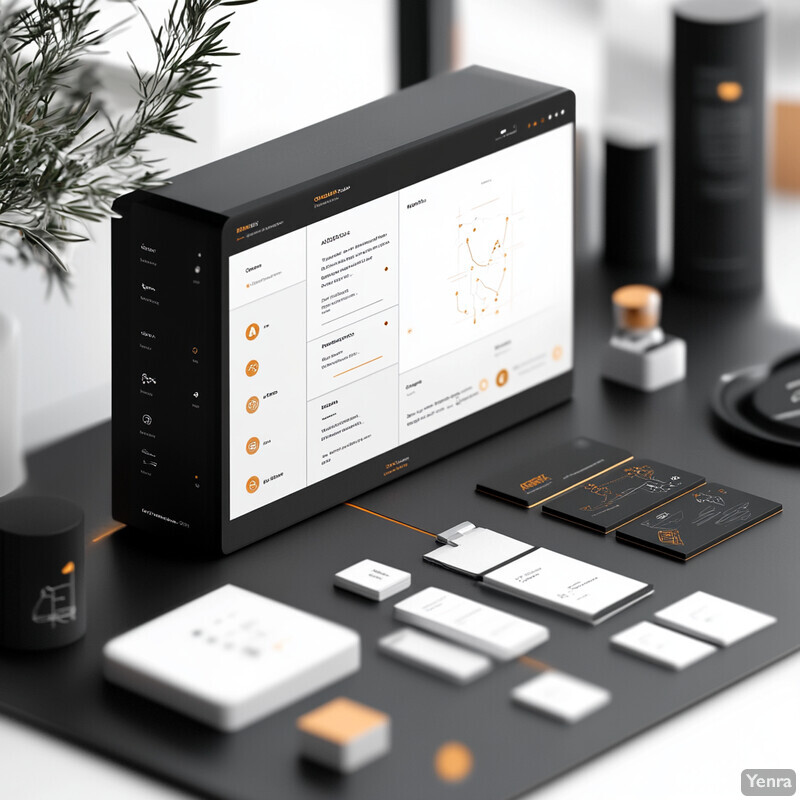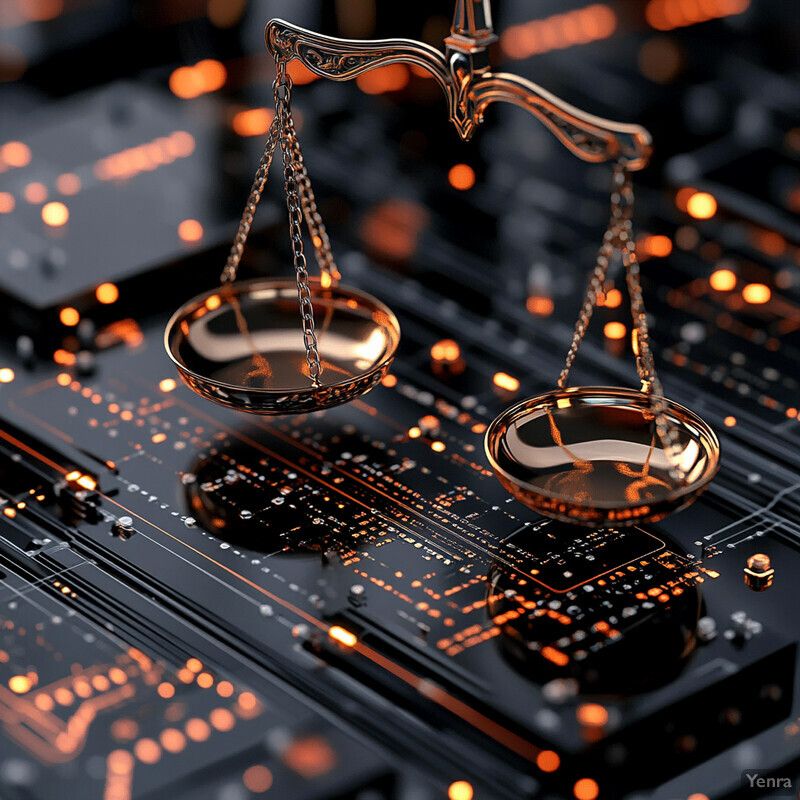1. Automated Data Classification
AI-driven data classification systems automatically sort and label information based on sensitivity and regulatory requirements. By identifying personal data like PII or PHI across large, unstructured datasets, these tools streamline data governance. They reduce the need for manual classification, which can be error-prone and inconsistent. In doing so, organizations can more reliably enforce policies such as encryption or access controls on sensitive categories. Overall, automated classification supports compliance by ensuring that data is handled according to its sensitivity level from the moment it’s ingested.
AI-driven tools can automatically identify and classify data according to sensitivity and compliance requirements (e.g., identifying personally identifiable information or protected health information), thereby streamlining data governance processes.

The adoption of AI for data classification is rapidly increasing as organizations recognize its efficiency. For example, IDC analysts estimated that AI-based classification tools would automate 70% of personally identifiable information tagging tasks by 2024. Likewise, a Gartner survey reported 60% of compliance officers plan to invest in AI-powered regulatory technology by 2025, reflecting a broad shift toward proactive data management. These trends indicate that companies are leveraging AI to handle growing data volumes and complex privacy rules more effectively. By automating classification, firms aim to minimize human error and improve consistency, which in turn helps meet obligations under laws like GDPR and CCPA. Early adopters have noted improved operational efficiency and stronger data protection postures as a result of AI-driven classification initiatives.
AI-driven data classification tools leverage machine learning algorithms to sift through vast amounts of organizational data—both structured and unstructured—and categorize it based on sensitivity levels and regulatory requirements. By continually learning from patterns, these systems can distinguish personally identifiable information (PII) or protected health information (PHI) from general business data with increasing accuracy. This automated classification minimizes human error, reduces the time spent on manual labeling, and ensures that sensitive data is appropriately flagged for protections like encryption or access restrictions. Ultimately, this supports a more robust data governance framework, enabling organizations to maintain compliance more easily while reducing operational costs and risks associated with mismanaged data.
2. Sensitive Data Redaction
AI-based redaction tools use natural language processing (NLP) to detect and mask sensitive information in documents and communications. This ensures that when data is shared or published, personal identifiers like names, social security numbers, or credit card details are removed or obscured. By automating this process, organizations can more confidently share datasets or respond to information requests without risking privacy leaks. Such tools operate much faster than manual redaction and maintain consistency across thousands of pages or images. Ultimately, automated redaction supports compliance with privacy laws by preventing unauthorized exposure of protected data.
Natural Language Processing (NLP) models can detect and anonymize sensitive information in documents, ensuring that only privacy-compliant data is shared or stored, reducing the risk of inadvertent data leaks.

The need for reliable redaction is underscored by breach statistics. In 2023, the most commonly compromised data types in breaches were customer personal data (about 52% of incidents) and employee personal data (40%). This indicates that a majority of data breaches involve exposure of sensitive PII, highlighting why robust redaction is critical. AI-driven redaction software has demonstrated high accuracy in identifying these details, often flagging information that humans might overlook. Companies that deployed automated redaction reported significant time savings in document processing and reductions in inadvertent disclosures. By swiftly sanitizing documents, these AI tools help organizations comply with regulations like HIPAA or GDPR’s data minimization and confidentiality requirements, and avoid the heavy fines that can result from exposing personal information.
Natural Language Processing (NLP) models and other advanced AI techniques can scan through unstructured text—such as documents, emails, and recorded transcripts—and automatically identify content that might violate privacy regulations. This includes names, social security numbers, credit card details, and other identifiable elements. Once identified, these tools can effectively obscure or remove this information, ensuring that any data leaving secure environments is appropriately sanitized. This automated redaction process not only helps organizations comply with data protection regulations like the GDPR or HIPAA but also streamlines workflows, allowing data sets to be safely shared for analytics, research, or other legitimate business purposes without endangering individuals’ privacy.
3. Adaptive Access Control
Adaptive access control refers to AI-enhanced systems that adjust user permissions dynamically based on context and behavior. Instead of relying solely on static roles or credentials, these systems evaluate factors like login location, device health, time of access, and user activity patterns in real time. If something appears anomalous (e.g., a user logging in at an unusual hour from a new location), the system can require additional authentication or temporarily limit access. This approach aligns access rights with real-time risk, ensuring that only legitimate, context-verified requests reach sensitive data. It significantly bolsters data privacy by preventing unauthorized or high-risk access attempts that traditional static controls might miss.
Machine learning algorithms can dynamically adjust user access rights based on behavioral patterns, context, and risk scoring, ensuring that sensitive data is only accessible under secure and compliant conditions.

Organizations that have adopted adaptive, risk-based access controls as part of a Zero Trust security model report tangible benefits. According to a Deloitte analysis, companies implementing Zero Trust (which often includes AI-driven adaptive access) experienced up to 35% fewer security incidents compared to those using traditional static controls. This reduction is attributed to the system’s ability to catch unusual access events and block or step up authentication in response. For instance, if an employee’s account is suddenly used from abroad when they typically work from the U.S., the AI can flag or stop the login before any data is viewed. Such real-time adjustments thwart many insider threats and compromised credential attacks. With adaptive access, compliance with regulations requiring strict data access controls (like PCI DSS or HIPAA) is strengthened, as the technology ensures only appropriate and verified access to protected information at all times.
Modern AI-based access control systems go beyond static user roles and permissions by employing continuous risk assessment. They analyze behavioral patterns, user context, device reputation, and real-time network conditions to determine whether granting access to sensitive data is justified at that moment. For example, if a user who typically accesses a database from a secure office network suddenly attempts to log in from a suspicious IP address at an unusual time, the system may require additional authentication or block access. This adaptive approach to permissions enhances data privacy by ensuring only the right individuals access the right data under the right conditions, directly supporting compliance mandates that require strict control of sensitive information.
4. Real-Time Privacy Policy Enforcement
Real-time privacy policy enforcement uses AI to continuously monitor data transfers and user actions, instantly checking them against privacy rules and regulations. Instead of finding compliance violations after the fact (during audits or breaches), these AI systems act as sentinels that intercept potentially non-compliant activities as they happen. For example, if an employee attempts to email a database extract containing customer SSNs, the system can automatically block the email or redact the sensitive fields. This immediate response prevents improper data sharing or exports that violate policies like GDPR, HIPAA, or company-specific rules. By enforcing privacy constraints in real time, organizations can significantly reduce the window of exposure and demonstrate proactive compliance.
AI can continuously monitor data flows in real-time, automatically blocking or flagging activities that violate privacy and regulatory policies before a breach or compliance incident occurs.

Many organizations struggle with detecting policy violations quickly, leading to costly delays. Studies show that only about 33% of companies discover data breaches or policy breaches internally through their own monitoring, whereas 67% learn of issues from external sources or attackers. Those externally discovered incidents tend to incur nearly $1 million more in costs on average due to the delayed response. This underscores the value of catching problems immediately. AI-driven enforcement helps flip that statistic by spotting and halting violations inside the organization, before outsiders or damage can occur. Moreover, privacy regulations have strict requirements (for instance, GDPR mandates breach notifications within 72 hours), so preventing a breach outright is far preferable. Real-time AI policy enforcement has been credited with reducing data leakage incidents and providing detailed logs that regulators appreciate during compliance assessments. It shifts organizations from a reactive stance to a preventative one, significantly lowering the risk of sanctionable privacy lapses.
AI-driven compliance engines can continuously monitor network traffic, database queries, and user activities against established privacy and data protection policies. As these tools operate in real-time, they can immediately flag—or even automatically block—policy violations before sensitive data is improperly shared or exposed. By doing so, organizations can enforce compliance requirements proactively rather than relying on reactive audits. This kind of enforcement reduces the window of opportunity for data breaches, helps maintain strict adherence to regulatory frameworks (like CCPA or GDPR), and offers clear audit trails that demonstrate an organization’s proactive stance on privacy enforcement to regulators and stakeholders.
5. Automated Compliance Reporting
Automated compliance reporting uses AI to gather, analyze, and compile the information needed for regulatory reports and audits. Instead of staff manually collecting logs and evidence from various systems, an AI system can continuously aggregate data on security controls, user activities, and compliance metrics. When it’s time to produce a report (for example, an annual GDPR compliance report or a SOX IT control report), the system can automatically generate it in the required format. This not only saves time but also increases accuracy – by minimizing human error and ensuring no required detail is overlooked. AI can even customize reports for different regulations or stakeholders (regulators, auditors, executives) on the fly. Overall, automation in compliance reporting reduces the administrative burden and helps organizations demonstrate adherence to laws promptly and precisely.
AI-based systems can generate detailed compliance reports and audit trails with minimal human intervention, reducing manual overhead and increasing accuracy in demonstrating adherence to regulations.

Organizations that implemented AI for compliance documentation have seen notable improvements in efficiency. In industry case studies, companies using AI-driven tools reported up to a 40% boost in efficiency for compliance analysis and reporting tasks. Routine reports that once took weeks of manual effort can now be generated in minutes with minimal human intervention. For example, AI systems can pull data from multiple source systems (logs, databases, HR records) and populate an audit checklist or risk assessment report automatically, with all required evidence attached. According to a 2024 Techjury analysis, these tools not only speed up the reporting process but also flag potential compliance issues in real time, allowing teams to address them before formal reports are due. This proactive insight means fewer surprises during audits. As a result, organizations using automated compliance reporting are better able to meet tight regulatory deadlines and focus their staff on higher-level compliance strategy rather than paperwork.
Traditionally, compliance reporting involves manual compilation of records, audit logs, and user activities—a tedious and error-prone process. AI-based tools simplify this by automatically aggregating and analyzing relevant data, generating comprehensive compliance reports that highlight adherence to key regulations, potential policy violations, and remediation actions taken. These reports can be customized to meet specific regulatory standards and can be generated on-demand or scheduled regularly. As a result, organizations gain a transparent, auditable record of their compliance posture, reducing the administrative burden and human effort required, while also improving the accuracy and reliability of compliance documentation.
6. Proactive Data Breach Detection
Proactive data breach detection involves AI systems continuously scanning networks, user behavior, and system logs to spot signs of a breach before significant damage is done. These AI tools learn what normal patterns look like in an organization’s data flows. When anomalies occur – say a user suddenly accessing a large volume of files at 2 AM or unusual data transmissions to an external server – the AI raises an immediate alarm or even intervenes. This early warning allows security teams to investigate and contain threats in their infancy. Essentially, AI-driven breach detection shifts defense from a passive stance (waiting to react to an obvious breach) to an active one (hunting for hints of trouble). This capability is crucial for privacy compliance because many regulations (like GDPR, CCPA) require prompt breach identification and containment to protect personal data.
By analyzing network traffic, user behavior, and system logs, AI systems can detect anomalous patterns indicative of potential breaches earlier, limiting unauthorized data exposure and aiding compliance.

The impact of AI on breach detection speed is well documented. Organizations with fully deployed AI-based security monitoring detected and contained breaches significantly faster – roughly 108 days quicker on average – than organizations without such AI, according to IBM’s 2023 research. In concrete terms, companies using security AI identified and contained a breach in about 247 days, versus 355 days for those relying on traditional methods. This acceleration in detection/response can mean the difference between a minor incident and a major data exposure. Faster detection not only limits how much personal data attackers can steal but also helps companies meet strict breach notification timelines. Moreover, IBM found that the extensive use of AI and automation in security lowered the average cost of a breach by nearly $1.8 million, partly because issues were caught and remediated before escalating. These statistics underscore that AI-driven proactive detection isn’t just a theoretical benefit – it materially reduces both the scale and cost of data breaches, directly supporting compliance with breach notification and minimization requirements.
AI enhances data security and compliance by detecting unusual patterns in data access and system usage that could indicate a breach or malicious activity. These machine learning models are trained to differentiate between normal user behavior and anomalies that might represent unauthorized access attempts, insider threats, or data exfiltration. By identifying these signs early, organizations can intervene before significant damage occurs. This early-warning capability is instrumental in maintaining compliance with regulations that require timely breach notifications and minimized data exposure. Proactive detection not only helps avoid the hefty fines and reputational damage associated with breaches but also assures regulators and customers that privacy safeguards are continuously monitored and improved.
7. Context-Aware Consent Management
Context-aware consent management is the use of AI to ensure individuals’ consent for data use is obtained and honored according to the relevant legal and cultural context. In practice, this means an AI system can adjust consent forms and workflows based on where the user is located, the type of data being collected, and applicable laws (GDPR in Europe, LGPD in Brazil, state laws in California, etc.). For example, the AI might present a European user with a GDPR-compliant consent prompt in their language, but adapt for a U.S. user by referencing CCPA opt-out rights instead. It can also track when consent needs to be refreshed – say if data is going to be used for a new purpose, or if a law changes requiring new consent. By automating these nuances, organizations ensure they always request, record, and respect user consent in a compliant way. This builds trust with users and regulators that personal data is only collected and processed with proper permission.
AI can interpret different legal jurisdictions and data usage scenarios to ensure that consent gathering and usage align with regulations like GDPR, automatically updating consent forms or prompting for re-consent when needed.

The regulatory landscape for consent is highly fragmented globally, making manual compliance challenging. As of 2024, 137 countries have enacted their own data privacy laws, many with distinct consent requirements. This means a multinational company potentially faces over a hundred different standards for how consent must be obtained or what it must include. Furthermore, regulations like the GDPR impose strict penalties for improper consent – fines can reach up to €20 million or 4% of global revenue for violations. In practice, differences in legal interpretations (for instance, what constitutes valid consent, or the age at which a child can consent) have led to confusion and uneven enforcement across jurisdictions. AI-based consent management tools tackle this complexity by continuously updating consent flows to match current laws in each locale. Companies using such tools report more consistent compliance with local consent rules and fewer user complaints. By keeping consent practices context-aware and up-to-date, AI helps organizations honor individuals’ rights and avoid regulatory pitfalls in every region they operate.
Consent requirements differ based on jurisdiction, the nature of collected data, and the intended use of that data. AI-driven systems help organizations navigate these complexities by dynamically determining when and how user consent should be obtained or refreshed. They consider factors like local regulations, user preferences, and historical user interaction patterns to present contextually appropriate consent notices. This ensures that data collection and usage always align with relevant laws—such as GDPR’s explicit and informed consent mandates—and that user rights are respected. With automated consent management in place, organizations maintain a consistent and compliant approach to data handling, building trust with their users and regulatory bodies alike.
8. Privacy-by-Design Recommendations
Privacy by design is the principle of embedding privacy considerations into products and processes from the outset, rather than as an afterthought. AI can assist this by providing recommendations to developers and engineers during the software development lifecycle. For instance, an AI code analysis tool might scan a new application’s code and flag sections that handle personal data, suggesting encryption or tokenization at those points. It could alert a design team if a feature is collecting more data than necessary (violating data minimization) or if user data is being logged in plain text. The AI essentially acts as a smart assistant, knowledgeable about privacy best practices and relevant laws, guiding the team to make safer design choices (like pseudonymizing identifiers, or adding an opt-in consent step before a sensitive action). By heeding these AI recommendations, organizations can build systems that inherently comply with privacy regulations and are less prone to costly redesigns or fixes later.
During software development, AI-powered code analysis tools can identify privacy risks and suggest design modifications that adhere to best practices and regulatory guidelines, embedding compliance early in the lifecycle.

Embracing privacy by design yields measurable benefits but isn’t yet universal. An ISACA global survey in 2024 found that while a large majority of privacy professionals see privacy-by-design practices as valuable for improving customer trust and compliance, many organizations struggle with implementation due to lack of awareness, tools, or resources. Specifically, common failures like not incorporating privacy checks or training during development were linked to increased data breaches and compliance issues in that survey. On the positive side, organizations that did institute privacy by design in their processes reported better outcomes – the same report noted these organizations tend to have more staff dedicated to privacy, stronger alignment between privacy and business objectives, and higher confidence in meeting new regulatory demands. AI-driven recommendation tools aim to bridge the gap by making it easier for teams to apply privacy principles. Early adopters have seen reductions in privacy incidents post-deployment because potential issues (like insecure data storage or excessive data collection) were caught in the design phase. In sum, AI is helping translate the theory of privacy by design into practical action, ensuring compliance is built into systems from day one.
Incorporating privacy considerations from the start of the software development lifecycle is a core principle of modern data protection frameworks. AI-powered code analysis and architectural evaluation tools can identify potential privacy risks in software designs and offer recommendations to mitigate them before deployment. These tools might suggest encrypting certain data fields, prompting pseudonymization of sensitive attributes, or advising adjustments to data retention strategies. By injecting privacy best practices early in development and continually refining these approaches with feedback loops, organizations reduce the likelihood of future compliance issues and make it simpler to maintain strong data protection postures over time.
9. Risk Scoring and Prioritization
Risk scoring and prioritization involves using AI to evaluate various data processing activities or systems and assign them a “privacy risk” score. This helps organizations focus their compliance efforts where it matters most. For example, an AI might assess that a marketing database containing millions of customer records with personal information is “high risk,” whereas an internal email directory is “low risk.” It does this by looking at factors like volume of sensitive data, number of users with access, whether the data is shared externally, past incidents, etc. The output is a ranked list of systems or processes by risk level. With this, privacy officers can prioritize audits, enhancements, or oversight on the riskiest operations (perhaps the top 10% that pose the greatest potential impact if something went wrong). By intelligently ranking risks, AI ensures that limited compliance resources address the most significant vulnerabilities first, improving overall data protection.
Machine learning models can assess the potential privacy risk of various data-processing activities, helping organizations prioritize resources for the most vulnerable areas and ensure compliance with evolving regulations.

Traditional manual risk assessment methods often miss subtleties and consume a lot of staff time. Research indicates that human-led compliance risk reviews typically catch only about 60–70% of potential issues, leaving a considerable gap. Additionally, compliance teams report spending up to 20–40% of their working hours just identifying and cataloguing risks across the organization. AI-based risk scoring tools dramatically improve this situation. They can analyze massive datasets (logs, access records, data inventories) in seconds, spotting patterns that humans might overlook – such as cumulative access privileges that create excessive risk or combinations of data that heighten privacy impact. By one account, companies using AI for risk assessment have managed to reduce the time spent on risk identification by nearly half while increasing the consistency of their risk ratings. Importantly, this approach aligns with regulatory expectations: frameworks like ISO 27701 and NIST privacy guidance encourage a risk-based approach to privacy compliance. Early adopters of AI risk scoring have been able to show regulators a clear, data-driven rationale for where they focus their compliance efforts, which is viewed favorably during inspections. Overall, AI provides a quantifiable, evidence-based way to tackle privacy risks proactively and efficiently.
One of the most challenging aspects of data governance and compliance is determining which processes, datasets, or applications pose the highest privacy risks. AI-based risk scoring models evaluate factors like data sensitivity, access frequency, external sharing, and past incidents to assign risk scores to data assets or activities. Armed with these insights, compliance officers can prioritize their efforts, focusing resources on the most vulnerable or impactful areas. This data-driven prioritization ensures that organizations address compliance gaps efficiently and effectively, improving their overall data protection strategy and aligning their controls with the highest return on privacy investment.
10. Automated Data Minimization
Data minimization is the principle of collecting and retaining only the minimum personal data necessary for a specific purpose. AI helps enforce this by identifying redundant, outdated, or trivial data (often called “ROT” data) in corporate systems and recommending what can be deleted or anonymized. Over time, organizations accumulate vast troves of personal information – much of which may no longer be needed for operations. AI algorithms can scan databases and file storage to flag, for example, multiple copies of the same customer records, old transaction logs beyond retention policy, or fields in a dataset that are never used. By automating this discovery, AI gives privacy teams a clear map of excess data. The tool might then suggest safe deletion of certain datasets or replacement of sensitive data with synthetic or aggregated alternatives. Implementing these suggestions keeps the data footprint lean, reducing risk exposure and simplifying compliance since there is less personal data to secure and justify keeping.
AI-driven systems can identify redundant or unnecessary data and recommend safe deletion or sanitization strategies, ensuring organizations handle only the minimal amount of personal data required by law.

Modern organizations store enormous amounts of data, much of which is never actually utilized. Industry research reveals that as much as 80–90% of enterprise data storage consists of unstructured “dark data” that isn’t actively used. This unused data not only incurs storage costs but also represents a latent privacy risk – if it contains personal information, it could be breached or misused even though it serves no business purpose. Studies estimate only about 20% of stored data is mission-critical and regularly accessed for decision-making. These statistics underscore why regulators embed data minimization in laws like GDPR (which explicitly requires that personal data be “adequate, relevant and limited” to what is necessary). AI-driven minimization efforts have shown success in practice: companies that deployed AI tools to purge unnecessary data saw significant reductions in their overall data holdings and reported a lower incidence of security issues, since the potential breach surface shrank. For instance, one global firm using AI for data housekeeping found that roughly 30% of their stored records were duplicates or outdated and were able to safely eliminate them, freeing up storage and reducing compliance scope. By continuously pruning data stores, AI ensures organizations adhere to retention limits and minimize the personal data under their care – a key strategy to comply with regulations and to mitigate breach impact.
Data protection regulations often emphasize the principle of data minimization, requiring that organizations only collect and retain the minimal amount of personal data needed to achieve their purposes. AI-driven tools can examine storage systems, identify redundant or outdated data, and recommend safe deletion or aggregation methods. These recommendations help organizations avoid unnecessary data retention, reducing the attack surface and compliance risks associated with holding excessive personal information. Automated data minimization not only aligns with legal obligations like GDPR’s “data minimization” principle but also streamlines database management and lowers storage costs over the long term.
11. Synthetic Data Generation for Compliance Testing
Synthetic data generation involves creating artificial datasets that resemble real data but contain no actual personal identifiers. AI plays a central role here by learning the patterns and statistical properties of an original sensitive dataset (for example, a customer database) and then generating a new dataset that has similar characteristics but is entirely artificial. This synthetic data can be safely used in testing, analytics, or development without exposing real individuals’ information. For compliance, this means companies can develop and QA their systems or share data with partners in a privacy-preserving way. Since the synthetic records do not correspond to real people, the usual privacy regulations (GDPR, HIPAA, etc.) become far less of a concern when handling that data. Essentially, synthetic data allows organizations to fulfill purposes like software testing or machine learning model training in a manner that inherently protects personal privacy.
AI can generate synthetic, privacy-preserving datasets that mirror the properties of real data without containing identifiable information, supporting compliance-friendly testing and analytics.

Synthetic data is quickly becoming a staple for privacy-conscious organizations. Gartner projected that by 2024, over 60% of data used in AI and analytics projects will be synthetically generated rather than taken directly from production. This indicates a major shift toward embracing fake data for real use-cases. The reason is twofold: the volume of data needed for advanced analytics is huge and growing, and privacy laws are increasingly restricting the use of real personal data for secondary purposes. Companies have reported that synthetic datasets enabled them to comply with regulations during software testing – for example, a bank could test a new mobile app using synthetic customer profiles instead of real customer data, thus avoiding violating any privacy rule while still getting accurate test results. Advances in AI generative models have made synthetic data remarkably realistic; one MIT study noted synthetic data can be so representative that models trained on it perform as if trained on the real thing. Importantly, regulators are supportive of this approach: data protection authorities often advise using de-identified or synthetic data in place of real personal data whenever possible. In summary, AI-driven synthetic data offers a win-win: innovation and analysis can continue, and individual privacy remains safeguarded.
For testing analytics models, product features, or new data-driven services, developers often need access to realistic data. However, using real customer data in testing environments can raise privacy risks. AI-fueled synthetic data generation creates artificial datasets that closely resemble the statistical properties of genuine data—without including identifiable information. This ensures developers, data scientists, and quality assurance teams can perform robust testing, training, and validation without exposing sensitive information. By preserving realism while protecting privacy, synthetic data supports compliance in scenarios where the use of live data would otherwise jeopardize privacy regulations.
12. Support for Regulatory Updates
The regulatory environment for data privacy is continually evolving — new laws emerge, and existing ones frequently update or get reinterpretations. AI tools help compliance teams keep up by automatically tracking these changes and mapping them to the organization’s practices. For instance, an AI system might scan news feeds, government websites, and legal databases for any update on privacy laws worldwide. When it finds a change (say a new state privacy law or an amendment to GDPR guidelines), it can alert the compliance officers and even suggest what internal policies or notices might need updating. These systems can also maintain calendars of compliance deadlines (like annual filings or assessment requirements) across different jurisdictions. By having AI sift through the noise and flag what’s relevant, organizations can remain agile and ensure their privacy programs adapt promptly to the latest rules. This prevents situations where a company is caught non-compliant with a newly effective law simply because they missed the announcement.
AI models can track global regulatory changes, interpret the implications, and suggest updates to privacy policies and compliance frameworks, aiding organizations in remaining compliant as laws evolve.

Companies face an enormous challenge staying current given the sheer volume of global privacy regulations. In 2024, there were 138 countries with data protection or consumer privacy laws on the books. Additionally, within federations like the U.S., individual states have been enacting their own laws – by 2024, about a quarter of U.S. states had passed state-level privacy legislation. On top of that, regulatory bodies issue hundreds of updates, guidelines, or enforcement actions annually; one industry report noted over 200 regulatory updates per year that could affect compliance programs. No human team can manually monitor all these without help. AI regulatory monitoring tools have proven invaluable here: organizations using AI for this purpose report a greatly reduced risk of missing critical legal changes. In fact, according to FinTech Global, companies leveraging AI saw a 50% reduction in the time required to implement necessary changes after a new regulation is introduced. For example, when the California Privacy Rights Act (CPRA) amendments took effect, an AI tool might automatically highlight needed policy revisions and draft updated consent forms, cutting down the adaptation period. Such responsiveness not only avoids non-compliance penalties but also demonstrates good faith effort to regulators. By staying ahead of regulatory updates through AI, businesses can continually fine-tune their compliance posture in near-real-time, despite the fast-paced legislative landscape.
The legal landscape surrounding data privacy is dynamic and ever-evolving. AI tools can regularly scan legal repositories, regulatory bulletins, and official announcements across multiple jurisdictions to track changes in compliance requirements. By interpreting these regulations and mapping them to current policies and workflows, the AI can suggest necessary adjustments—such as updating privacy notices, altering data retention schedules, or refining consent mechanisms. This ongoing vigilance helps organizations remain compliant even as new laws come into effect, mitigating the risk of penalties and ensuring that data-handling practices remain in harmony with the latest standards.
13. Deepfake and Identity Fraud Detection
The rise of AI-generated fake media (deepfakes) has introduced new risks to data privacy and identity verification. AI-driven detection tools have become crucial for identifying when a piece of content (like a voice recording or video) has been manipulated or when someone is impersonating another individual. These tools work by analyzing media for telltale signs of AI generation – for example, irregularities in facial movements, glitches in audio frequencies, or inconsistencies in lighting and shadows in videos. In the context of compliance, such tools help maintain the integrity of identity verification processes (preventing fraudsters from using deepfake videos to pass biometric checks) and protect individuals from having their likeness misused. They also ensure that organizations can trust the authenticity of the communications and documents they receive. By deploying AI that can quickly flag a likely deepfake or synthetic identity, companies reinforce compliance with “know your customer” regulations and other identity-related obligations.
Advanced AI models can identify manipulated content, fraudulent activity, or impersonation attempts, maintaining data integrity and compliance with identity verification mandates.

Deepfake-based fraud has exploded in prevalence, making detection technology increasingly essential. Globally, reported deepfake fraud incidents increased by over 10× from 2022 to 2023. In 2023 alone, at least 500,000 deepfake videos or audio clips were circulating on social media, some of which were used for scams and misinformation. High-profile examples include forged audio of company CEOs used to trick employees into transferring funds, and bogus videos of public figures causing confusion or reputational damage. A Deloitte poll in 2024 found roughly 26% of executives had encountered a deepfake incident in their organization, illustrating how commonplace the threat has become. In response, companies are adopting AI-powered verification checks: for instance, many banks now use liveness detection during video KYC to catch when an on-screen person might actually be a deepfake. The FBI even warned in 2023 that almost 40% of online scam victims were targeted with deepfake content, underscoring the need for countermeasures. AI detection systems have risen to the challenge — some boast accuracy rates well above 90% in identifying fake vs. real media. By integrating these into their security and compliance workflows, organizations can uphold data integrity, ensure authentic communications, and comply with identity verification standards despite the new deepfake threat.
As the sophistication of deepfakes and impersonation attacks grows, so does the need for advanced defenses. AI-based detection systems analyze subtle visual, audio, and behavioral cues to identify manipulated content or fraudulent activities. By preventing identity fraud, impersonation, and malicious manipulation, these tools help maintain data integrity and user trust. Compliance frameworks often mandate strong identity verification and secure access controls, and AI-driven deepfake detection strengthens these compliance measures by ensuring that only legitimate, verified users can interact with sensitive systems and data.
14. Integrated Data Encryption and Tokenization Advice
AI-driven advisory tools for encryption and tokenization help organizations decide how best to protect different types of data. Encryption involves converting data into a coded format that requires a key to decode, while tokenization replaces sensitive data with non-sensitive “tokens” that reference the real data stored securely elsewhere. Deciding what data to encrypt, what to tokenize, and what level of encryption to use can be complex. An AI advisor can analyze the sensitivity of data, usage patterns, and compliance requirements to suggest optimal protection measures. For example, it might recommend strong encryption (AES-256) for databases containing Social Security numbers, but suggest tokenization for a credit card number field so that the actual numbers are never stored in full. It could also point out data that isn’t encrypted where it should be (e.g., a sensitive column in plaintext) or flag weak encryption configurations that need updating. By following these recommendations, companies implement robust data security aligned with compliance standards (like PCI DSS for payment data or healthcare data encryption rules under HIPAA).
AI-driven recommendations help determine the appropriate level and method of data encryption or tokenization, ensuring compliance with data protection standards and reducing the risk of exposure.

Given the high stakes of data breaches, most organizations are prioritizing encryption strategies, but implementation gaps remain. A global encryption trends study in 2023 found about 70% of organizations have an enterprise encryption strategy that is now a primary focus, yet actual adoption of these strategies is only around 50% on average across industries. In the same study, 65% of respondents ranked protecting customer personal information as their top encryption priority, reflecting regulatory pressure and customer expectation to safeguard data. AI can help close the strategy-to-implementation gap by providing clear guidance on where and how to apply encryption or tokenization. For instance, if an AI tool scans an environment and finds sensitive customer data stored unencrypted, it can immediately highlight that as a risk (and even apply encryption automatically in some cases). Encryption advisory AI can also keep track of evolving cryptographic standards – ensuring that companies move away from deprecated algorithms in favor of strong, compliant ones. Notably, as of 2024, new privacy laws (like India’s PDPB and various U.S. state laws) explicitly encourage or require encryption of personal data, especially if it’s being transferred or stored in cloud systems. Organizations using AI to guide their encryption/tokenization efforts tend to have fewer incidents of unencrypted data exposure and are better prepared for compliance audits, where they can demonstrate that appropriate encryption controls are in place for all high-risk data.
Deciding how to protect data—whether through encryption, tokenization, or anonymization—can be complex. AI advisory systems can evaluate data sensitivity, regulatory mandates, and environmental constraints to recommend the appropriate level and method of data protection. They may suggest strong encryption algorithms for especially sensitive data or tokenization strategies for data that must remain partially identifiable for certain workflows. By aligning encryption and tokenization approaches with regulatory requirements and best practices, these AI systems help organizations implement robust security and privacy controls that stand up to audits and reduce compliance headaches.
15. Automated Vendor Risk Management
Automated vendor risk management uses AI to continuously evaluate and monitor the privacy and security practices of third-party partners and service providers. Companies often share data with vendors (for cloud storage, marketing, analytics, etc.), and those vendors must comply with privacy standards too. AI systems can aggregate information about a vendor – such as scanning their security certifications, breach history, financial stability, and even scanning news feeds for any incident or fine involving that vendor. They can then assign a risk score to each vendor and alert when that risk changes (for example, if a vendor suffers a data breach or their compliance certification expires). Additionally, AI tools can ensure that proper data processing agreements are in place and even monitor data flows to confirm that a vendor is only using data for permitted purposes. By automating this oversight, companies can manage a large ecosystem of vendors and ensure they all uphold the required level of data protection, which is a direct requirement of laws like GDPR (which mandates due diligence on processors).
AI systems can evaluate third-party vendors’ privacy practices, detect possible compliance issues, and continuously monitor vendors to ensure they maintain appropriate privacy standards over time.

Third-party risk is a major concern, as evidenced by how frequently vendors are implicated in data breaches. A recent survey reported 61% of companies experienced a data breach caused by one of their third-party providers in the last year. In fact, another study found a staggering 98% of organizations have at least one vendor that has had a breach in the past – essentially almost every company is exposed through its supply chain. These statistics explain why regulators (and savvy boards) expect robust vendor risk management. Many firms are turning to AI due to the scale of the issue: large enterprises can have hundreds or thousands of suppliers handling personal data in some form. AI-based platforms have been shown to reduce the effort in vendor assessments by automatically gathering evidence – for example, retrieving a vendor’s certifications or probing their systems for known vulnerabilities. Moreover, they perform continuous monitoring, whereas a traditional vendor review might be only annual. The payoff is clear in the data: companies using continuous AI monitoring of third parties have been able to identify vendor-related issues sooner and mitigate them, often avoiding potential breaches. As of 2025, about 61% of organizations report using some level of AI or automation in their security risk management (which includes vendor risk). This aligns with regulatory expectations in frameworks like ISO 27001 and the NIST supply chain risk guidance, which emphasize ongoing vendor oversight. In summary, AI enables a proactive and scalable approach to ensuring all partners maintain compliance, thereby extending an organization’s privacy protection across its entire supply chain.
Many organizations outsource data-processing tasks to third-party vendors, creating extended ecosystems of compliance obligations. AI-driven vendor risk management platforms continuously monitor these vendors’ cybersecurity posture, regulatory adherence, and incident history. If a vendor’s risk profile changes—due to a discovered vulnerability or a known compliance violation—the AI system can alert compliance officers who can take timely action, such as renegotiating terms, requesting remediation steps, or even terminating the contract. By proactively identifying and mitigating vendor-related risks, organizations can maintain strong compliance postures and protect their supply chains from data breaches and regulatory penalties.
16. Behavioral Analytics for Insider Threats
Behavioral analytics for insider threats involves using AI to monitor the behavior of employees and internal users to detect anomalies that could indicate misuse of data. Insiders (employees, contractors, etc.) often have legitimate access to systems, so traditional security might not flag their actions as suspicious. However, AI can learn baseline patterns for each user or role – such as typical working hours, the usual data accessed, normal download volumes – and then identify deviations. For instance, if an employee who normally logs in from the office and accesses at most 10 records per day suddenly logs in at midnight remotely and bulk downloads hundreds of records, the AI system will recognize this out-of-character behavior and alert security or compliance teams. By catching these early, organizations can investigate potential insider threats (whether malicious or accidental) before they lead to a data breach. This is vital for compliance because many regulations (like HIPAA for healthcare or SOX for financial data) require monitoring of authorized users and ensuring they don’t abuse their access.
By analyzing user activities for unusual behavior, AI-based monitoring can alert compliance officers to potential insider threats to data privacy, allowing for timely intervention and reducing regulatory risks.

Insider incidents are on the rise and are very costly when they occur. The Ponemon Institute’s 2023 global report on insider risks revealed the average annual cost of insider threat incidents for organizations was about $16.2 million, a figure that had grown by 40% over four years. On average it took companies 86 days to contain an insider incident, from occurrence to resolution. Furthermore, the frequency of insider incidents has sharply increased – one analysis noted a nearly 95% jump in the number of insider threats since 2018. These statistics underscore the need for better monitoring. AI-based behavioral analytics directly addresses this by significantly reducing detection and response times. Companies that have implemented such systems have seen a reduction in “dwell time” of insider threats – often being able to respond in days instead of months. In some cases, AI algorithms have caught employees attempting to siphon data off to personal devices or cloud drives, actions that would otherwise go unnoticed until much later. Early detection not only prevents large-scale data losses but also helps maintain compliance with data protection requirements (since insider breaches must often be reported and can incur penalties). By using behavioral analytics, organizations create an internal alarm system that guards personal data from misuse by those on the inside, which is a complement to all the perimeter defenses against external hackers.
Insider threats—where employees or contractors misuse their legitimate access—pose a significant compliance risk. AI-based behavioral analytics tools scrutinize user activities, looking for suspicious patterns such as unusual login times, abrupt spikes in data downloads, or attempts to access previously untouched sensitive files. By correlating these anomalies with established norms, AI systems can alert compliance and security teams to potential insider threats. Early detection of such activities prevents unauthorized data exposure, reduces the risk of regulatory non-compliance, and ensures that only authorized, trustworthy individuals can work with sensitive information.
17. Language and Jurisdictional Variance Handling
Large organizations often operate across multiple countries and regions, each with its own privacy regulations and languages. AI tools help by interpreting legal requirements from different jurisdictions and ensuring that an organization’s policies meet all the varying standards. For example, an AI system can parse privacy laws or regulatory guidance in dozens of languages – translating and comparing terms like “personal data” or consent requirements – and then highlight differences. It could alert that in one country, certain data (like biometric data) is classified as highly sensitive requiring explicit consent, whereas elsewhere it might not be. The tool can then guide the organization to adjust data handling practices or privacy notices for each jurisdiction appropriately. This function can also involve generating multi-language policy documents and notices that are consistent in meaning but compliant with local nuances (for instance, addressing users’ rights in the EU under GDPR vs. users’ rights under Brazil’s LGPD). By automating the understanding of regional differences, AI ensures that a company remains compliant everywhere it operates, respecting the unique legal and cultural expectations around privacy.
NLP and other AI models can parse legal texts in multiple languages, adapting compliance strategies to local data protection laws, ensuring that global organizations can maintain compliance everywhere they operate.

The complexity of managing global privacy compliance is illustrated by the sheer number of laws and their differences. As of 2024, roughly 71% of countries worldwide have data protection legislation in place, but these laws can diverge widely in definitions and requirements. For instance, what qualifies as valid consent or the age threshold for consent may differ between the EU, the U.S., and Asia-Pacific nations, leading to potential confusion. A count by the International Association of Privacy Professionals noted 137 national privacy laws in effect, each requiring nuanced compliance efforts. Multinational companies have to produce privacy notices and contractual clauses in dozens of languages, often updated whenever local laws change. AI aids this by accurately translating and contextualizing legal terms – far beyond a simple literal translation. Companies using AI for this purpose have managed to maintain a single coherent global privacy policy that auto-adjusts per region. For example, after the enactment of China’s Personal Information Protection Law (PIPL) in 2021, AI tools were used by some firms to rapidly identify necessary policy changes and generate updated bilingual consent forms reflecting PIPL’s stricter requirements on data localization and third-party sharing. The outcome is that organizations can demonstrate compliance not just in one jurisdiction, but across all: AI provides a form of automated legal research and implementation. This is increasingly important as regulators coordinate and perform cross-border reviews – a company might be audited in the EU and need to show how it also complies in, say, Brazil and Japan. AI’s ability to harmonize policies with local variance is becoming essential to managing this mosaic of privacy obligations.
Global organizations must navigate a patchwork of data protection laws that vary by country, region, and even industry. NLP-based AI systems can parse legal texts and guidance in multiple languages, automatically mapping them to an organization’s data policies. By harmonizing these diverse requirements, the AI tools help maintain consistent compliance across borders. This level of nuance ensures that data-handling practices respect local privacy rights, consent rules, and reporting obligations, thereby preventing costly legal disputes and allowing multinational entities to operate with confidence in multiple jurisdictions.
18. Enhanced Incident Response
When a privacy or security incident occurs (like a data breach), an organized and swift incident response is critical. AI-enhanced incident response tools assist by automating and orchestrating many of the response steps. This can include immediately classifying the incident type and severity, notifying the appropriate internal teams, suggesting containment measures (such as isolating affected servers or revoking certain user credentials), and even drafting initial notifications to regulators and individuals if needed. Essentially, the AI can act like a crisis management coordinator that never sleeps – ensuring no time is lost and no required step is forgotten in the chaotic period following an incident discovery. Such tools often come with playbooks mapped to regulatory requirements, so if a breach of personal data is detected, the AI knows that regulators might need to be informed within a set timeframe and can prepare those communications. By streamlining response and ensuring thorough documentation of actions taken, AI helps companies both mitigate harm faster and meet their compliance obligations during breaches (like mandatory notification and root-cause analysis).
When a privacy breach occurs, AI can automate parts of the incident response—prioritizing tasks, suggesting remediation steps, generating required notifications to regulators, and documenting the process for audits.

Prompt incident response markedly reduces the impact of data breaches. According to IBM’s analysis, companies that were able to identify and contain a breach in under 200 days incurred an average cost of $3.93 million, whereas those that took longer (over 200 days) faced around $4.95 million in costs. This nearly $1 million difference illustrates how timeliness can save money and protect consumers. Regulations also enforce timeliness: GDPR Article 33, for example, requires that personal data breaches be reported to authorities within 72 hours of discovery. AI-driven incident response platforms directly support meeting these expectations. In practice, companies using such AI have cut down their incident triage and notification times dramatically. For instance, an organization without automation might take days of meetings to figure out what happened and whom to alert, whereas an AI-assisted process can often provide a full incident report within hours of detection. Industry surveys show about 74% of breaches involve some human element of error or oversight, which suggests that during a crisis, manual processes are prone to miss something. AI eliminates some of that human error by following a predefined response plan meticulously every time. Additionally, it keeps detailed logs of every action taken during the incident, which becomes invaluable evidence of compliance when regulators review how the breach was handled. Companies that have faced breaches with AI support have generally been able to notify affected individuals and authorities faster and more accurately, mitigating legal penalties and preserving customer trust better than those who responded slowly or haphazardly.
When a data breach or privacy incident occurs, swift and structured action is critical to meet compliance obligations and mitigate damage. AI-supported incident response platforms streamline this process by analyzing the nature of the breach, identifying affected data, recommending immediate containment steps, and suggesting communication strategies for notifying regulators and impacted individuals. By optimizing the order and urgency of response activities, these systems reduce the time it takes to restore compliance and trust. Detailed audit trails of the incident response process further assure regulators that the organization managed the incident responsibly and transparently.
19. Improved Employee Training and Education
Human error is a leading cause of data privacy incidents, so improving employee awareness and behavior is a core part of compliance. AI-driven training platforms personalize privacy and security education for each employee. Instead of one-size-fits-all annual training, an AI system can adapt modules to focus on areas where a particular employee or role needs improvement (for example, if an employee frequently clicks on phishing simulations, the AI will provide extra phishing awareness training). These platforms often use interactive and engaging techniques, potentially even AI-powered chatbots or simulations, to reinforce learning. They can also adjust the difficulty and topics in real time: if an employee aces certain quizzes, the AI might skip redundancies and move to more advanced content. The result is more effective training — employees truly learn how to handle data properly, recognize privacy risks, and follow procedures — which in turn reduces compliance failures. Moreover, AI can measure training outcomes (not just completion rates, but changes in behavior like fewer incidents caused by mistakes) and continuously refine the program.
AI-driven personalized learning platforms can tailor privacy and compliance training modules to individual employee roles and knowledge gaps, ensuring the workforce is up-to-date with the latest regulations.

Investing in training is clearly warranted by statistics: studies have found that human factors contribute to roughly 74% of data breaches (e.g., via mistakes or falling for scams). Recognizing this, 86% of organizations now offer privacy or security awareness training to their staff on at least an annual basis. However, traditional training often emphasizes completion over effectiveness. AI-driven training is changing that landscape. Early adopters of AI-personalized training have reported measurable improvements – for example, companies saw significant drops in phishing click-through rates and compliance violations after rolling out AI-tailored learning programs. One global study noted that the average employee only retains a fraction of generic training material, but when content was adaptive and relevant to their role, knowledge retention and proactive compliance behaviors improved by over 30%. Another benefit is scalability: with AI tutors, organizations have been able to increase training frequency (short micro-lessons throughout the year) without overwhelming the compliance team, because the AI handles content delivery and user support. Regulators too are starting to focus on training efficacy; during audits, they may ask how you ensure employees understand their privacy obligations. Companies using AI analytics can provide data – for instance, showing improvement in quiz scores or decreased incidents post-training – as evidence that their workforce is truly up-to-date. This strengthens the overall compliance posture, as well-trained employees serve as a strong first line of defense against data mishaps.
Human errors remain a leading cause of data breaches and compliance failures. AI-driven training programs customize educational modules based on an employee’s role, past performance in compliance quizzes, and observed behavior (e.g., frequency of clicking suspicious links). These adaptive learning systems ensure that each team member gains a strong understanding of the latest data privacy policies and best practices, while also reinforcing areas of weakness. As employees become more knowledgeable and vigilant, the organization’s overall compliance posture improves, reducing the risk of accidental data leaks and regulatory violations.
20. Continuous Improvement Through Feedback Loops
One of AI’s greatest strengths is the ability to learn from experience. In the context of privacy compliance, this means AI tools can continuously improve their accuracy and effectiveness by incorporating feedback from real incidents, audits, and user interactions. For example, if an AI data loss prevention system initially produces some false alarms, analysts can mark those as false positives; the AI will then adjust its models to reduce similar false alerts in the future. Likewise, when a genuine incident occurs that wasn’t caught, the system can ingest the details of that event to better detect similar patterns going forward. This feedback loop creates a virtuous cycle: the more the compliance AI operates and is tuned with feedback, the smarter and more finely tuned it becomes. Over time, the AI’s policies and detection rules evolve in step with emerging threats and changing business processes. This continuous improvement ensures that a company’s compliance controls don’t stagnate – they adapt dynamically, providing resilience against new challenges. Essentially, the AI and the compliance team learn together from every success or miss, steadily strengthening the organization’s privacy safeguards.
AI systems can gather outcomes from audits, investigations, and reported incidents, then refine models and rules to improve future detection, prevention, and compliance strategies, creating a virtuous cycle of advancement in data privacy.

Companies leveraging AI in their privacy and security programs have observed significant year-over-year performance gains as a result of continuous learning. According to the IBM 2024 Cost of a Data Breach analysis, organizations that extensively used AI and automation had an average breach cost of $3.84M, compared to $5.72M for organizations that did not use these technologies – about a 45% difference in cost . A big reason for this gap is that AI-driven programs get better each year: the report noted that the number of organizations using AI “extensively” rose by 10 percentage points, reflecting growing trust in the technology’s ability to improve outcomes. Concrete examples of improvement include a steady decline in false positive rates for AI-based monitoring systems after deployment – some companies reported that after a year of feedback tuning, their AI system’s false alerts dropped by over 30%, focusing investigators’ time only on real issues. Likewise, detection rates of certain risky behaviors (like improper data downloads) increased as the AI learned what it had initially missed and adjusted thresholds or patterns. Regulators and standards also encourage this adaptive approach; frameworks like ISO 27701 and NIST emphasize iterative risk management and improvement. By incorporating audit findings and incident reports into AI model updates, organizations create a self-correcting compliance ecosystem. Over time, this leads to fewer incidents, fewer audit findings, and an overall stronger culture of privacy, as the AI continuously refines the rules that employees and systems are governed by. In short, continuous feedback loops turn compliance from a static checklist into a dynamic, learning process – with AI as the engine driving persistent enhancement.
One of the great strengths of AI is its capacity to learn from experience. Compliance and privacy tools can integrate feedback from audits, investigations, and post-incident analyses directly into their models. This creates a virtuous cycle: each compliance review, breach investigation, or regulatory update informs the AI’s decision-making processes and detection strategies. Over time, the system becomes more adept at anticipating privacy risks, identifying vulnerabilities, and recommending effective controls. Continuous improvement helps organizations stay ahead of evolving threats and rapidly changing regulations, ensuring a more resilient and compliant data ecosystem.